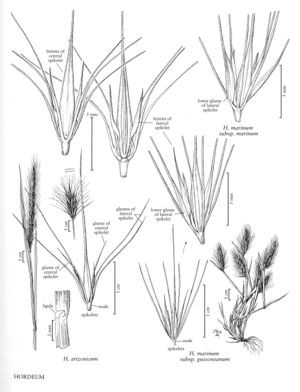Hordeum arizonicum
Plants annual to biennial, perennial under favorable conditions; forming small tufts. Culms 21-75 cm, rarely geniculate, not bulbous; nodes glabrous. Lower sheaths pub¬escent; upper sheaths glabrous; ligules 0.6-1.8 mm; auricles absent; blades to 13 cm long, to 4 mm wide, flat, glaucous, both surfaces scabrous, hairy, sometimes only sparsely hairy. Spikes 5-12 cm long, 6-10 mm wide, erect, often partially enclosed at maturity, pale green. Glumes bent, strongly divergent at maturity. Central spikelets: glumes 11-28 mm long, 0.2-0.4 mm wide, flattened near the base, setaceous above the middle; lemmas 5-9 mm, glabrous, awned, awns 10-22 mm; anthers 1-2.2 mm. Lateral spikelets sterile; glumes to 27 mm long, 0.2-0.4 mm wide, flattened near the base; lemmas 2.5-5 mm, unawned or awned, awns to 3 mm, lemma and awn together to 7 mm, the transition from the lemma to the awn gradual. 2n = 42.
Distribution
Calif., Ariz., N.Mex.
Discussion
Hordeum arizonicum grows in saline habitats, along irrigation ditches, canals, and ponds in the south¬western United States and northern Mexico. It is a segmental allopolyploid between H. jubatum and either H. pusillum or H. intercedens.
Selected References
None.
